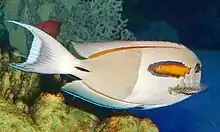Acanthurus olivaceus
Acanthurus olivaceus, the orange-band surgeonfish, the orange-shoulder surgeonfish or the orangebar tang,[1] is a species of marine ray-finned fish belonging to the family Acanthuridae, this family includes the surgeonfishes, unicornfishes and tangs. It lives in the tropical waters of the Indo-west Pacific.[3]
| Acanthurus olivaceus | |
|---|---|
 | |
| Scientific classification | |
| Domain: | Eukaryota |
| Kingdom: | Animalia |
| Phylum: | Chordata |
| Class: | Actinopterygii |
| Order: | Acanthuriformes |
| Family: | Acanthuridae |
| Genus: | Acanthurus |
| Species: | A. olivaceus |
| Binomial name | |
| Acanthurus olivaceus Bloch & J. G. Schneider, 1801 | |
| Synonyms[2] | |
| |
Taxonomy
Acanthurus olivaceus was first formally described in 1801 by the German naturalists Marcus Elieser Bloch and Johann Gottlob Theaenus Schneider with its type locality given as Tahiti in the Society Islands,[4] This species is closely related to the range restricted Marquesas surgeonfish (A. reversus), and together these taxa form a species complex within the genus Acanthurus.[5] The genus Acanthurus is one of two genera in the tribe Acanthurini which is one of three tribes in the subfamily Acanthurinae which is one of two subfamilies in the family Acanthuridae.[6]
Description
The orange band surgeonfish is a deep-bodied, laterally-compressed oval fish, rather over twice as long as it is deep, with a maximum length of 35 cm (14 in), although a more typical length is 25 cm (10 in). Both dorsal and anal fins are long and low, extending as far as the caudal peduncle. The dorsal fin has nine spines and 23 to 25 soft rays while the anal fin has three spines and 22 to 24 soft rays. The tail fin is crescent-shaped, the points growing longer as the fish gets older. The adult fish is greyish-brown; a sharp vertical line usually separates the paler front half of the fish from the darker hind portion. There is a distinctive orange bar, surrounded by a purplish-black margin, immediately behind the top of the gill cover, and blue and orange lines at the bases of the fins. Like all surgeonfish, this species has a pair of scalpel-like scales that project upward from the caudal peduncle. Larger males develop a convex snout which clearly differentiates them from females. Juvenile fish are yellow.[7][2]
Distribution and habitat
This fish is found in the tropical eastern Indian Ocean and the western Pacific Ocean. Its range extends from Christmas Island and the Cocos Keeling Islands to southern Japan, Western, Northern and Eastern Australia, Indonesia, the Philippines and Hawaii. It is associated with reefs, often on outer slopes and in more exposed locations. As an adult, it is a solitary fish or sometimes joins schools, with a depth range of between about 9 and 46 m (30 and 150 ft), but juveniles are found in shallower water in sheltered locations in small groups.[1]
Ecology
The orange band surgeonfish feeds on detritus and on algae growing on the seabed, as well as the film of diatoms and filamentous algae that grows on sand and other substrates.[2] It often forms schools with parrotfish, tangs and other species of surgeonfish, which all have similar diets; their grazing is important in maintaining biodiversity by keeping rocks free from excessive growth of algae so that coral larvae can find suitable habitat to settle. The fish can change colour from dark to pale almost instantaneously.[8]
Status
The orange band surgeonfish has a wide distribution in the tropical Indo-Pacific region and is moderately common. It is sometimes found in fish markets and in the aquarium trade but is not a species targeted by fisheries. No particular threats have been recognised, so the International Union for Conservation of Nature has listed its conservation status as being of least concern.[1]
References
- Russell, B.; McIlwain, J.; Choat, J.H.; et al. (2012). "Acanthurus olivaceus". IUCN Red List of Threatened Species. 2012: e.T177991A1514102. doi:10.2305/IUCN.UK.2012.RLTS.T177991A1514102.en. Retrieved 10 January 2018.
- Froese, Rainer; Pauly, Daniel (eds.) (2023). "Acanthurus olivaceus" in FishBase. June 2023 version.
- "Acanthurus olivaceus: Distribution". Encyclopedia of Life. Retrieved 3 May 2014.
- Eschmeyer, William N.; Fricke, Ron & van der Laan, Richard (eds.). "Species in the genus Acanthurus". Catalog of Fishes. California Academy of Sciences. Retrieved 28 September 2023.
- Michelle R. Gaither; Moisés A. Bernal; Richard R. Coleman; et al. (2015). "Genomic signatures of geographic isolation and natural selection in coral reef fishes". Molecular Ecology. 24 (7): 1543–1557. doi:10.1111/mec.13129.
- J. S. Nelson; T. C. Grande; M. V. H. Wilson (2016). Fishes of the World (5th ed.). Wiley. pp. 497–502. ISBN 978-1-118-34233-6.
- "Acanthurus olivaceus: fiche poisson" (in French). AquaPortail. Retrieved 8 April 2020.
- Lillie, Terry (28 April 2019). "Meet Na'ena'e the orange band surgeonfish". The Garden Island. Retrieved 13 April 2020.
External links
- Orangespot Tang care sheet at FishGeeks
- Encyclopedia of Life: Acanthurus olivaceus (Orange Shoulder Tang)
- Photos of Acanthurus olivaceus on Sealife Collection
